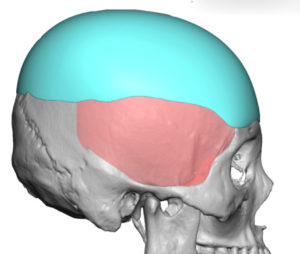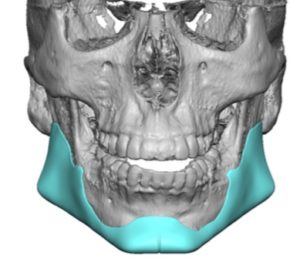
One of the very common questions patients ask about facial implants, and in particular custom implants, is what will happen to them if they are exposed to external trauma. With the implant fracture, become displaced or even make the bone more susceptible to being fractured? Most of these questions are based on potential sports-related trauma such as being struck in the face (e.g., boxing) or to the head (e.g., soccer) and, occasionally, a punch to the jaw outside of sports. I will address my comments to custom skull and jawline implants to which many of these questions are directed.

The basic biomechanical concept to explain how custom skull and jawline implants provide this added layer of trauma protection is force displacement or deflection . Force displacement refers to the obvious that the implant acquires the traumatic force application before the bone. How well it handles the force and how much is transferred to the bone depends on the elastic deformation characteristics of the implant. While all implant materials undoubtably allow force displacement from the underlying bone how effective they are in that regard depends on how hard it is to fracture them. (elastic vs plastic deformation)
In comparing solid silicone vs PEEK materials, for example, silicone has a very high elastic deformation property. This is best envisioned by taking a hammer to a sold block of rubber…you wouldn’t be able to fracture it no matter how hard it was struck. Conversely PEEK, while being a strong plastic material, has a much lower capability for elastic deformation and can be fractured. It is a common misconception amongst patients that a material that can be bent is weak while those that are more rigid are stronger. In reality, a material that can undergo large elastic deformations is better able to absorb stresses than a less deformable material which is more prone to break. While no specific biomechanical studies have ever been done comparing such implants on the bone, all implant materials currently used in custom implants (silicone, porous, polyethylene, PEEK and titanium) provide more than adequate bone protection from almost any practical traumatic force application.
Such larger surface coverage implants also obviously provide more bone protection than smaller ones.(e,g., standard chin implant vs custom jawline implant) The more bone that is covered, the greater the bone protection becomes. This is why I often refer to custom skull and jawline implants as being the equivalent of placing a ‘bumper’ on the bone.
The other custom implant concern patients have is whether it can become displaced or loose if exposed to trauma. While patients understandably are focused on the use of screws during implant placement, they are not what is responsible for maintaining the position of the implant long-term. The use of screws is important at the time of implant placement and in the first month or so after surgery for maintenance of implant position. But beyond that time period the formation of scar tissue around the implant, known as the capsule, is what secures the position of an implant. This scar tissue formation is thick and causes a significant ‘shrink wrap’ effect around the implant to the bone. This capsule, which extends around the entire implant on all of its surfaces, provides an incredibly firm method of fixation into whatever the implant’s position was as it formed. Such capsule formation is considerable in larger custom skull and facial implants. Force applications in one site of the implant can not cause this enveloping scar to rupture ever such a large surface area and allow the implant to be displaced.
In summary, custom skull and jawline implants provide bone protection from injury as well as have a vey likelihood of every being displaced from any type of traumatic injury, particularly those related to sports participation,
Dr. Barry Eppley
Indianapolis, Indiana




